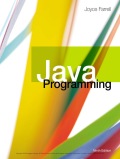
Explanation of Solution
a.
Program code:
Lease.java
//define the class Lease
public class Lease
{
//declare class members
private static final double PET_FEE = 10;
private String tenantName;
private int apartmentNumber;
private double monthlyRent;
private int leasePeriod;
//Default constructor
public Lease()
{
//initialize the class members
tenantName ="XXX";
apartmentNumber =0;
monthlyRent = 1000;
leasePeriod =12;
}
//getters and setters
//define a method getTenantName()
public String getTenantName()
{
//return the variable tenantName
return tenantName;
}
//define a method setTenantName()
public void setTenantName(String tenantName)
{
//set the value of tenantName
this.tenantName = tenantName;
}
//define a method getApartmentNumber()
public int getApartmentNumber()
{
//return the variable apartmentNumber
return apartmentNumber;
}
//define a method setApartmentNumber()
public void setApartmentNumber(int apartmentNumber)
{
//set the value of apartmentNumber
this.apartmentNumber = apartmentNumber;
}
//define a method getMonthlyRent()
public double getMonthlyRent()
{
//return the variable monthlyRent
return monthlyRent;
}
//define a method setMonthlyRent()
public void setMonthlyRent(double monthlyRent)
{
//set the value of monthlyRent
this.monthlyRent = monthlyRent;
}
//define a method getLeasePeriod()
public int getLeasePeriod()
{
//return the variable leasePeriod
return leasePeriod;
}
//define a method setLeasePeriod()
public void setLeasePeriod(int leasePeriod)
{
//set the value of leasePeriod
this.leasePeriod = leasePeriod;
}
//define a method addPetFee()
public void addPetFee()
{
//adds $10
monthlyRent+=PET_FEE;
}
//define a method explainPetPolicy()
public static void explainPetPolicy()
{
//print the statement
System.out.println("Add $10 to rent as pet fee.");
}
}
Explanation:
The above snippet of code is used create a class “Lease”. The class contain different static methods for store the details of a lease. In the code,
- Define a class “Lease”
- Declare the class members.
- Define the constructor “Lease()” method.
- Initialize the class members.
- Define the “getTenantName()” method.
- Return the value of the variable “tenantName”.
- Define the “setTenantName()” method.
- Set the value of the variable “tenantName”.
- Define the “getApartmentNumber()” method.
- Return the value of the variable “apartmentNumber”.
- Define the “setApartmentNumber()” method.
- Set the value of the variable “ApartmentNumber”.
- Define the “getMonthlyRent()” method.
- Return the value of the variable “MonthlyRent”.
- Define the “setMonthlyRent ()” method.
- Set the value of the variable “MonthlyRent”.
- Define the “getLeasePeriod()” method.
- Return the value of the variable “leasePeriod”.
- Define the “setLeasePeriod()” method.
- Set the value of the variable “leasePeriod”.
- Define the “addPetFree()” method.
- Set the value of “monthlyRent”.
- Define the “explainPetPolicy()” method.
- Print the statement.
b.
TestLease.java
//import the packages
import java.text.NumberFormat;
import java.util.Scanner;
//define a class TestLease
public class TestLease
{
//define main() method
public static void main(String[] args)
{
//declare the objects of the class Lease
Lease lease1 = new Lease();
Lease lease2 = new Lease();
Lease lease3 = new Lease();
Lease lease4 = new Lease();
//Call three times getdata()
lease1 = getData();
lease2 = getData();
lease3 = getData();
System.out.print("Display info of tenants\n\n");
//Print info
showValues(lease1);
showValues(lease2);
showValues(lease3);
showValues(lease4);
System...
Trending nowThis is a popular solution!

Chapter 3 Solutions
EBK JAVA PROGRAMMING
- Please answer Java OOP Questions.arrow_forward.NET Interactive Solving Sudoku using Grover's Algorithm We will now solve a simple problem using Grover's algorithm, for which we do not necessarily know the solution beforehand. Our problem is a 2x2 binary sudoku, which in our case has two simple rules: •No column may contain the same value twice •No row may contain the same value twice If we assign each square in our sudoku to a variable like so: 1 V V₁ V3 V2 we want our circuit to output a solution to this sudoku. Note that, while this approach of using Grover's algorithm to solve this problem is not practical (you can probably find the solution in your head!), the purpose of this example is to demonstrate the conversion of classical decision problems into oracles for Grover's algorithm. Turning the Problem into a Circuit We want to create an oracle that will help us solve this problem, and we will start by creating a circuit that identifies a correct solution, we simply need to create a classical function on a quantum circuit that…arrow_forwardNeed help with this in python!arrow_forward
 EBK JAVA PROGRAMMINGComputer ScienceISBN:9781337671385Author:FARRELLPublisher:CENGAGE LEARNING - CONSIGNMENTProgramming Logic & Design ComprehensiveComputer ScienceISBN:9781337669405Author:FARRELLPublisher:Cengage
EBK JAVA PROGRAMMINGComputer ScienceISBN:9781337671385Author:FARRELLPublisher:CENGAGE LEARNING - CONSIGNMENTProgramming Logic & Design ComprehensiveComputer ScienceISBN:9781337669405Author:FARRELLPublisher:Cengage Microsoft Visual C#Computer ScienceISBN:9781337102100Author:Joyce, Farrell.Publisher:Cengage Learning,
Microsoft Visual C#Computer ScienceISBN:9781337102100Author:Joyce, Farrell.Publisher:Cengage Learning, EBK JAVA PROGRAMMINGComputer ScienceISBN:9781305480537Author:FARRELLPublisher:CENGAGE LEARNING - CONSIGNMENT
EBK JAVA PROGRAMMINGComputer ScienceISBN:9781305480537Author:FARRELLPublisher:CENGAGE LEARNING - CONSIGNMENT C++ Programming: From Problem Analysis to Program...Computer ScienceISBN:9781337102087Author:D. S. MalikPublisher:Cengage Learning
C++ Programming: From Problem Analysis to Program...Computer ScienceISBN:9781337102087Author:D. S. MalikPublisher:Cengage Learning Programming with Microsoft Visual Basic 2017Computer ScienceISBN:9781337102124Author:Diane ZakPublisher:Cengage Learning
Programming with Microsoft Visual Basic 2017Computer ScienceISBN:9781337102124Author:Diane ZakPublisher:Cengage Learning





